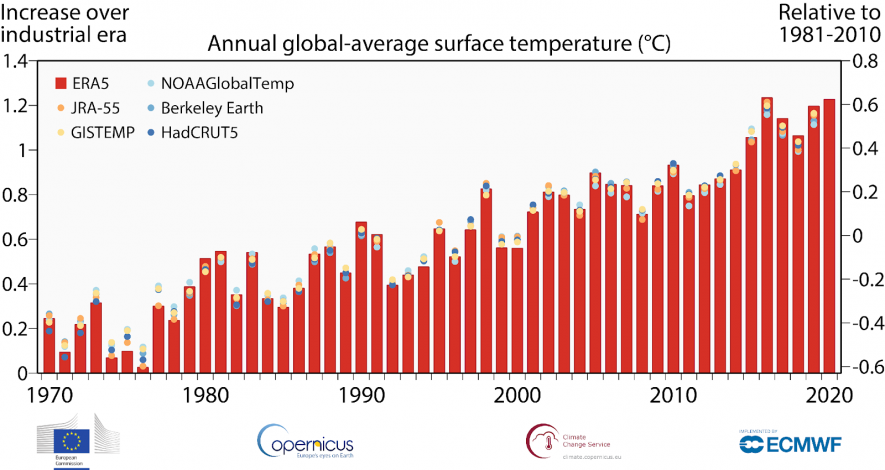Global Warming Emergency: 2020 Hottest Year Ever Recorded Along with 2016
Representational use only
Year 2020 witnessed the joint highest global temperature on record, along with 2016 which previously held the record for this heat.
But, it should be noted that 2016 saw a natural El Nino, a natural climatic event which leads to a rise in the temperature. El Nino is a periodical event where sea surface temperature across the central and east-central equatorial Pacific rises. Barring the El Nino in 2016, the year 2020 would have been the hottest year, according to data has released by the European Union’s Copernicus Climate Change Service (C3S) report recently.
The C3S report said that the average surface temperature across the globe in 2020 was 1.25 degree Celsius higher in comparison to the period 1850-1900, that is during the pre-industrial times. This global average temperature, alarmingly, is closer to the 1.50 degree Celsius target laid down in the Paris Agreement. The Paris Agreement’s target is based upon the aim to evade the worst possible impacts of the man-made climate change.
Moreover, year 2020 was the sixth in the series of exceptionally warm years that started in 2015 and the decade 2011-2020 has been the warmest one that has been ever recorded.
Interestingly, due to the lockdowns imposed globally due to the pandemic, there was a 7% decline in fossil fuel burning recorded globally. However, ironically, the building up of carbon dioxide, the heat trapping gas, did not cease parallel to the decline in fossil fuel burning. On the contrary, it continued to rise setting a new record.
Notably, 2020 matched with 2016 in warming not only in the absence of an El Nino, but also in the presence of La Nina, which is opposite to El Nino and has an overall cooling effect. The La Nina condition developed during the second half of the year, while, 2016 recorded strong El Nino at the beginning of the year.
The C3S report said, “In general, the Northern Hemisphere experienced above average temperatures for the year, apart from a region over the central North Atlantic.”
The figure below depicts the annual average global surface temperature as ratio between the pre-industrial era on the left hand axis and 1981-2010 on the right hand axis.

Image Source: C3S Website.
2020 also appeared to be the hottest in Europe, with 1.6 degree Celsius above the long-term average. Reports said that heat waves hit Western Europe during late July and early August.
More alarmingly, Arctic and northern Siberia witnessed extraordinary rise in average temperature in the year. Widespread areas of these regions saw temperatures 3 degree Celsius higher than the long term average while some areas recorded more than 6 degree Celsius higher.
These resulted in extensive wildfires in the Arctic regions, which eventually led to a record emission of 244m tonnes of carbon dioxide in the atmosphere. At the same time, Arctic sea ice was at a record low.
On a warning note, Carlo Bountempo, the director of C3S, said, “The year 2020 stands out for its exceptional warmth in the Arctic. It is no surprise that the last decade was the warmest on record, and is yet another reminder of the urgency of ambitious emissions reductions to prevent adverse climate impacts.”
Prof Dave Reay of Edinburg University, raised a similar concern saying, “Despite the absence of the cyclical boost of El Niño to global temperatures [we are] getting dangerously close to the 1.5C limit.”
He further added, “Covid lockdowns around the world may have caused a slight dip in emissions, but the CO2 accumulating in the atmosphere is still going up fast. Unless the global economic recovery from the nightmares of 2020 is a green one, the future of many millions of people around the world looks black indeed.”
Get the latest reports & analysis with people's perspective on Protests, movements & deep analytical videos, discussions of the current affairs in your Telegram app. Subscribe to NewsClick's Telegram channel & get Real-Time updates on stories, as they get published on our website.
























